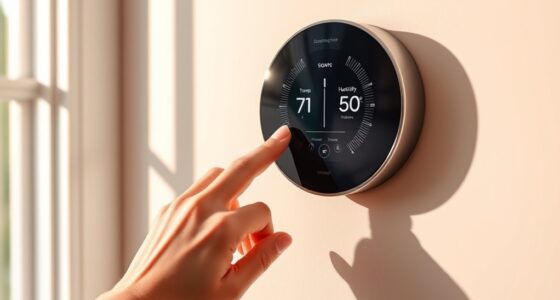To maximize energy efficiency with your heat pump, set your smart thermostat to create personalized zones and schedules. Keep bedrooms cooler during the day and warmer in the evening, and use zoning controls to adjust temperature in different areas. Enable Wi-Fi remote access to tweak settings when you’re away. Incorporate sensors like occupancy detectors to automatically optimize comfort and energy savings. Stay tuned for more tips on fine-tuning your system for even better performance and savings.
Key Takeaways
- Set lower temperature targets during unoccupied times to save energy without sacrificing comfort.
- Use zoning to heat or cool only occupied areas, reducing unnecessary energy consumption.
- Connect your thermostat to Wi-Fi for remote adjustments aligned with your schedule and avoid energy waste.
- Schedule temperature changes based on daily routines to optimize efficiency and comfort.
- Integrate sensors like occupancy or window detectors for dynamic adjustments that enhance heat pump performance.

Smart thermostat settings can markedly improve your home’s comfort and energy efficiency. When you optimize these settings, you not only enjoy a cozy environment but also save money on your energy bills. One of the most effective ways to do this is by utilizing zoning adjustments. Zoning allows you to control different areas of your home separately, ensuring that you’re heating or cooling only the spaces you use most. By setting specific temperatures for each zone, you prevent energy waste in unoccupied rooms, making your heat pump work more efficiently. For example, you might set the bedrooms to a cooler temperature during the day while keeping the living room warmer in the evenings. This targeted approach helps maintain comfort without overworking your system.
Another key aspect of smart thermostat settings is Wi-Fi connectivity. When your thermostat is connected to your home’s Wi-Fi, you gain greater control over your heating and cooling remotely. Whether you’re at work, on vacation, or just lounging in another room, you can adjust your thermostat through a mobile app. This flexibility means you can fine-tune your settings to match your schedule and preferences, reducing energy consumption when you’re away or asleep. Plus, many smart thermostats can learn your habits over time, suggesting ideal settings or automatically adjusting based on your routines, further enhancing efficiency.
To maximize benefits, start by setting up zoning adjustments in your home. Most modern smart thermostats support multiple zones, so you’ll want to create a zoning layout that reflects your home’s layout and usage patterns. Once set up, you can assign different temperature schedules to each zone, ensuring that each space is comfortable when in use and energy-efficient when not. Make sure your thermostat is connected via Wi-Fi, and familiarize yourself with its app. With remote access, you can easily adjust temperatures, set schedules, and monitor energy usage from anywhere. This not only helps in maintaining comfort but also prevents unnecessary energy waste.
Additionally, many smart thermostats allow for integration with other smart home devices, which can further optimize your heat pump’s performance. For example, integrating your thermostat with window sensors or occupancy detectors can help the system respond dynamically to changes in your home’s environment. When combined with zoning adjustments and Wi-Fi control, these features create a finely tuned heating and cooling system that works efficiently and adapts to your lifestyle. Ultimately, by leveraging these settings, you turn your heat pump into a smart, responsive system that enhances comfort while reducing your energy footprint. Exploring energy-efficient designs inspired by Victorian and Steampunk aesthetics can also add a unique charm to your home’s interior while supporting sustainable living.
Frequently Asked Questions
How Can I Optimize My Thermostat for Different Seasons?
You can optimize your thermostat for different seasons by using zoning strategies to target specific areas and prevent energy waste. Adjust temperature settings accordingly—lower in winter and higher in summer—and program your thermostat to match these changes. Incorporate occupancy sensors to detect when rooms are vacant, automatically adjusting settings for efficiency. These methods help maintain comfort while reducing energy consumption year-round.
What Are the Best Temperature Settings for Energy Savings?
Set your thermostat to 68°F during winter when you’re home and active, then lower it when you’re asleep or away to save energy. Use programming tips like scheduling different temperatures for specific times, and take advantage of user customization to adjust settings easily. During summer, keep temperatures around 78°F when you’re home and higher when you’re away. These adjustments help optimize energy savings without sacrificing comfort.
How Does Humidity Affect Thermostat Settings?
Humidity control considerably impacts your thermostat settings and comfort levels. When humidity is high, you might need to set your thermostat lower to prevent a muggy feeling and reduce discomfort. Conversely, in low humidity, you can comfortably set it a bit higher without sacrificing comfort. Adjusting your thermostat based on humidity helps maintain ideal comfort levels and can improve energy efficiency by reducing the workload on your heat pump.
Can Smart Thermostats Learn My Heating Preferences?
Yes, smart thermostats can learn your heating preferences using advanced learning algorithms. They observe your daily routines and adjust settings to match your comfort levels automatically. Over time, they refine their understanding based on your feedback and behavior, ensuring your home stays cozy when needed and energy-efficient when you’re away. This personalized approach helps you save money while maintaining ideal comfort, making your heating experience seamless and customized.
What Maintenance Is Needed for Optimal Thermostat Performance?
To keep your thermostat performing well, you should regularly replace or clean your HVAC filter to guarantee good airflow. Also, schedule system calibration annually to maintain accuracy in temperature readings. Check for software updates and reset your thermostat if it behaves oddly. These simple steps help your smart thermostat run efficiently, saving energy and extending its lifespan. Keep up with maintenance to enjoy consistent, comfortable heating and cooling.
Conclusion
By now, you see how smart thermostat settings can make your heat pump more energy-efficient and cost-effective. Don’t forget to set your thermostat wisely—think like a wise old sage from the days of yore but with modern tech at your fingertips. With these tips, you’ll be saving energy and money, all while keeping your home cozy. So, go ahead, embrace the future of home comfort—your wallet and the planet will thank you!









